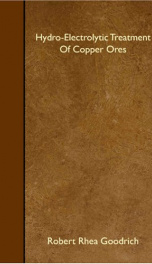hydro electrolytic treatment of copper ores

1914 - THE HYDRO-ELECTROLYTIC TREATMENT OF COPPER ORES - It is the intention of this paper to give a brief summary o f the practised and suggested hydrometallurgical processes for the extraction of copper from its ores. The review of the literature. as given contains the salient points of what has been done in the history of the subject. The problems of economically treating low-grade copper ores have turned the attention of metallurgists toward such hydrometallurgical problems as are encountered with low-grade siliceous, oxidized and sulphide ores, and concentrates, especiallywhere water-power is cheap and fuel is expensive. The treat--ment of tailings from concentrates is another promising field for leaching methods, there being no other known possible method for economically extracting their copper contents. The same is also true 0. f complex refractory ores which are not amenable to smelting for the recovery of their several metals. And, lastly, there are metallurgists who entertain hopes of discovering a leaching method which will radically change all methods of copper extraction to something quicker and cheaper than the present smelting methods. I. PURELYC HE IICA M L E THOD S l . Alkali processes. 2. Sulphite 3. Sulphate 4. Chloride Copper is dissolved and precipitated by chemical reagents. 11. ELECTR LY M T ET IC HO D S l. Sulphate processes. 2. Chloride 66 208 ROBERT RHEA GOODRICH. Copper is dissolved chemically and is precipitated electrolytically. The deposition is usually accompanied by regeneration of the solvent. All acids react more or less with the constituents of the ore, causing a. Consumption of acid. b. The bringing in of elements detrimental to the process. Iron, arsenic, antimony and bismuth, while detrimental, are not necessarily fatal to an acid process. If lime, magnesia, zinc or manganese occur in large quantities in the ore, acid processes are not applicable-the limit can o, nly be determined by experiment. While calcium carbonate is detrimental, calcium sulphate is not. Alumina is undesirable, but not riecessarily very injurious. Many oxidized ores are iniproved by roasting. All sulphide ores require roasting for most of the leaching processes, the exception being chalcocite ores, which may be leached direct. Greenawalt, Hydrometallurgy of Copper, 1912 Ed., Chap. IX. 1. Alkali Processes. The alkali processes have not met with much encouragement in the hydrometallurgical extraction of copper from its ores, due largely to the low and slow solubility of copper minerals in solutions of the alkalies. Ammonia and ammonium compounds are the only alkaline solvents tried for the leaching of copper oxide ores on a commercial scale. Greenawalt, p. 172. The Mosher-Ludlow Ammonia-cyanide Process. This process is applicable to ores containing oxide and carbonate of copper. At the ordinary temperature, ammonia NH, forms a stable compound Cu NH, , I which readily dissolves in water containing slight excess of ammonia...
Users who have this book
Users who want this book
What readers are saying
What do you think? Write your own comment on this book!
write a commentGenre
if you like hydro electrolytic treatment of copper ores try:
Other books by this author
Do you want to exchange books? It’s EASY!
Get registered and find other users who want to give their favourite books to good hands!

